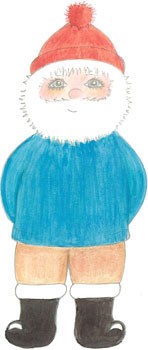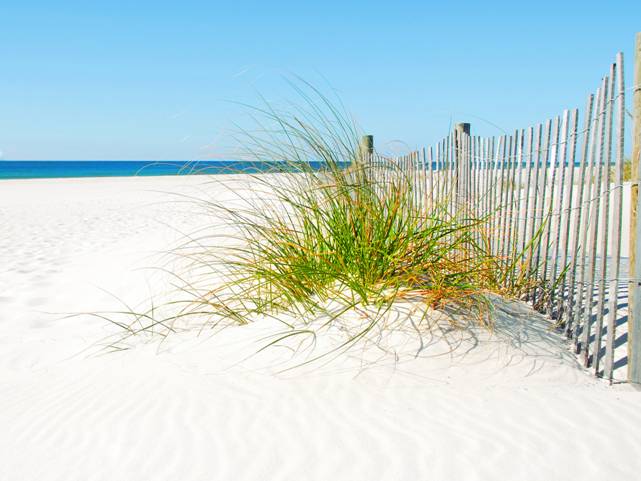
Salty Sam’s Fun Blog for Children
Number 513
Making Candles
Hello Everyone

Last Sunday afternoon, Bill and Bob’s mum, that is, my sister, sat down at the dining room table covered with newspaper and started to do some handicrafts.
Bill and Bob asked if they could help, and their mum politely declined, saying that she just wanted to decorate some candles to sell in her shop and the designs needed to be done properly.
She had some white candles and wanted to decorate them with a reddish-brown dye called henna. Henna comes from a plant called the henna tree or Egyptian privet. ln some parts of the world, women use it to paint patterns on their skin, in places like their hands and feet. These patterns are long-term, temporary tattoos.
She thought the patterns would make the candles look prettier and more interesting, and, of course, because they were hand-painted, each one would be unique.
She made simple flower shapes with five petals made of dots with a few dots spaced in between them. The finished design looked very effective.
Bill and Bob asked if they could make some candles, and their mum said that there are a couple of ways that children could make candles.
They could make candles by rolling up sheets of bees wax around a wick and pressing in the final edge to seal the sheet into itself to finish up with a cylinder.
Or they could use a candle making kit which had paraffin wax or soy wax chips that needed to be melted down and poured into a mould holding a wick.
You could add dyes to make different colours and fragrances to make different smells.
She said the moulds could be lots of different shapes, cylinders, pyramids, cubes or even animal shapes.
You could put white blocks of wax into a mould and then fill up the spaces with coloured wax and you could see the chunky effect in the finished candle.
Some kits had glass holders that you could use again and again.
When you make candles, you can use all sorts of different objects as candle holders as long as they are fire-proof and stable.
lf you have an odd cup or cup and saucer, you can make a candle inside it.
You can hold a wick in the centre of the cup by using a clothes peg resting on the edge while you pour the wax into the cup.
You then have to let the wax cool so that it solidifies.
lf you have odd ends of candles that are too small to light again, you can melt down all the odd bits and either mix them together to make a new colour if they are all different colours, or put the odd bits of melted, coloured wax in the mould one by one making sure each layer solidifies before you add the next.
You can even use an egg shell from a dippy egg that you have had.
Place the shell in something to hold it steady, and pull the shell away from the tiny candle when it is set.
lt will be interesting to see how the stripes have formed, when the shell is removed.
Work where you can make a bit of a mess. lf you drip hot candle wax onto a surface by mistake, it can be pulled or scraped off when it has set.
Some people make candles by putting damp sand into a large bucket and forming a three-dimensional shape in the sand like a cube and using this hole as a mould. To make the hole you can build the damp sand up around a cup or block of wood. The wick can be held in place with a tiny stick resting over the hole. The candles have a sand coating on the surface and look very rustic.
You parents might prefer it if they light any candles you make, and also oversee what you are doing while you are dealing with hot substances.
You have to be careful with candles and not ever leave them unattended.
They should always be placed in holders that are suitable, made from something like metal, ceramic, glass or stone and will not tip over.
The tiny flame is hotter than you think, so you should not lean across candles or leave them near fabrics.
lf you use them in the garden, you can put them in jars to stop the wind blowing them out; you can decorate the jars to make them into pretty lanterns by using glass paint on the outside.
Some people use candles to make an atmosphere romantic, and some use them to help them relax. Candles have long been associated with spiritual rituals and religious ceremonies.
They were the only light to use for those travelling through the night on the roads or by ship at one time. They would have been put inside lanterns to stop rain or wind extinguishing them (snuffing them out).
Candles have been in homes for thousands of years. They were used for light, and even to tell time when they were marked, or put on holders with evenly-spaced lines to show a number of hours.
They were made from whatever people could source locally.
The earliest Roman wicks were made from rolled papyrus. The Chinese used rice paper.
Animal fat which was called tallow would not smell nearly as nice as the candles made from beeswax. Wax could also be made from vegetables, seeds, fruit and nuts. Cinnamon was used in lndia.
Long candles were made by repeatedly dipping the two ends of a long wick into melted wax. The next wax layer would stick to the first layer of wax and soon the wick could not be seen as it was buried under the wax.
Each thin layer would be held in the air to dry and then the candle was built up in this way layer by layer.
When the candles were big enough they were hung up to fully set. The wick binding them together at the top would be trimmed down and then the pair would be separated into single candles to be put in store.
A monk would sit for hours patiently making candles.
Beeswax was more expensive than tallow, and beeswax candles would have been used by churches and wealthy people. Monasteries kept their own beehives for a supply of honey and wax. Beeswax has a naturally high melting temperature which means it tends to burn for a lot longer.
Tallow was available in far larger quantities than beeswax.
People who made and sold candles were called chandlers.
ln the 1400s, candles could be used as street lighting.
ln the 1700s, oil was provided in quantity by the whaling industry. Oil taken from the head of sperm whales did not smell nasty; it produced candles that did not bend on hot summer days and burned with a bright light. (Whale oil had been used in China hundreds of years earlier.)
All of this was, of course, very bad news for the whales.
ln the 1800s, candles were produced from stearin wax made from animal fatty acids. These candles were smokeless, unlike the tallow ones.
Candles began to be mass-produced in factories by machines and this made them cheaper.
Paraffin wax taken from coal and petroleum started to be used in candle-making the 1850s. lt was economical and burned cleanly. Paraffin candles had a low melting point, so they were hardened by adding stearin.
This was, of course, very good news for the whales.
Wicks were also developed. They were made from different materials like hemp (a kind of plant) and cotton and infused with chemicals to control speed of burning. Some of them were plaited.
(The width of your wick is important. lt has to be the right width according to the width of your candle. lf the wax melts too quickly, it will drown the wick and extinguish the flame.)
Then oil lamps became a better source of light, and later electricity was put into houses to use for lighting at the beginning of the 1900s. Candles fell out of fashion and were only used for special occasions like romantic dinners and Christmas.
From the 1990s, they became fashionable again.
Modern candles often use soybean wax or palm wax or flax-seed oil wax which are thought to be healthier than paraffin.
They have a huge array of potent scents to create a mood inside the home.
Of course, they are still used in churches, and are associated with prayer and thinking about deceased loved ones.
Bill and Bob’s mum said she would buy them a candle-making kit, and they could make some candles for the family for Christmas if they wanted to.
Making container candles are good for beginners.
After all, she was selling lots of things to people for their Christmas, and it was about time the family started planning for their own.
lf you like my blog, please support it by telling all your friends and followers about it.
Thank you!
And see you again next Fun Friday!
Love and kisses
Salty Sam

www.christina-sinclair.com
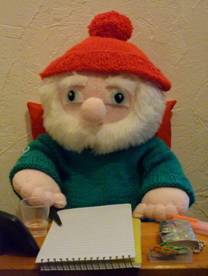

Bill and Bob’s Joke of the Week![]()
![]()
Bill: Why are you lighting that candle now Bob?
Bob: l am going to try and speak to the departed.
Bill: Oh okay, that makes séance.
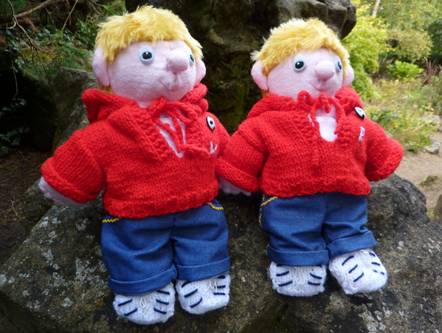
Salty Sam © Christina Sinclair 2015
Unauthorized use and/or duplication of material from this blog without express and written permission from this blog’s author and owner is strictly prohibited.
Links may be used to www.christina-sinclair.com

Picture Gallery
 A henna design
A henna design

 Hand-dipped candles
Hand-dipped candles

Lantern




 THE SALTY SAM NEWS DESK
THE SALTY SAM NEWS DESK

Tom Smith invented crackers in 1847. They were designed to look like huge bonbons and were filled with toys, paper hats and corny jokes.
Here is a pattern for some good-sized gift bags that you can leave on plates at dinner. They can be used afterwards as jewellery pouches or somewhere to keep a watch or some items of make-up for example.
You can use brown yarn to make them look like sacks, or red or green to make them look Christmassy, or with sparkly yarn like the bag in the picture to make them look really festive.
There is plenty of room inside to contain a really lovely present.
You can make the draw-string cord in the same colour or a contrasting colour.
NEWSDESK MINIMAKE
DINNER PLATE SANTA SACKS
BASE (KNIT ONE)
Using 4mm knitting needles and dk yarn cast on 18 stitches
Knit 20 rows of stocking stitch
Cast off
SIDES (KNIT FOUR)
Using 4mm knitting needles and dk yarn cast on 18 stitches
Knit 30 rows of stocking stitch
Knit 10 rows of garter stitch
Cast off
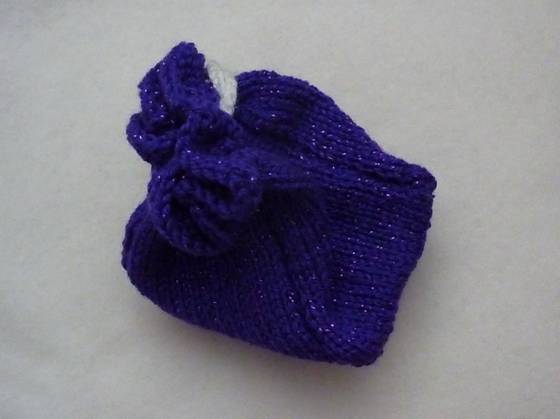
TO MAKE UP
Using over-sew stitching and with wrong sides together sew the bottom of the sides to the base
Sew up the corners
Crochet 90 chains into a length of yarn and weave this cord around the top of the sack above the bottom line of garter stitch

There are lots of Christmas jokes on Blog Post 409!

*********************
TO ADVERTISE ON THIS BLOG
PLEASE CONTACT:
christina.sinclair.ads@aol.co.uk
*********************

 Quick Quiz
Quick Quiz
What do these idioms mean?
- in the heat of the moment
- to warm to someone
- a hot potato
- in the hot seat
- in hot water
- a hot bed
- a heated discussion
- a hot topic
- hot under the collar
- a hot desk
- hot off the presses




lt’s the Weekend!

HOW TO MAKE PRESENT PLAQUES
If you have wrapped your presents in plain paper – maybe brown or white, and you think you need to jazz them up a bit here is a great idea to try out.
You need to find a shape to draw around to make a stencil to use.
Draw around this stencil – or a bottle top or other object, if that is easier.
Then make the shapes into pictures!
For example, if you are using star-shaped plaques, draw little faces on them.
Stick the card plaques on the wrapped present.
Then draw light streaks twinkling out of the stars.
If you are using circles, you could make them into smiley suns and draw sunbeams out of them once they are stuck into place on the wrapped present.
Use your imagination to see what other ideas you could come up with.
(The pattern for the present stocking in the picture is on Blog Post 505.)

Please note that the material on this blog is for personal use and for use in classrooms only.
It is a copyright infringement and, therefore, illegal under international law to sell items made with these patterns.
Use of the toys and projects is at your own risk.
©Christina Sinclair Designs 2015


Quick Quiz Answers
- in the heat of the moment – doing something without planning to do it
- to warm to someone – to begin to really like them
- a hot potato – something very hot to handle like a difficult problem
- in the hot seat – being the person who has to make often difficult decisions
- to be in hot water – to be in trouble
- a hot bed – a place where a lot is going on
- a heated discussion – arguing
- a hot topic – something that is being talked about a lot at the current time
- hot under the collar – annoyed and angry
- a hot desk – a desk in an office that is available to anyone who needs to sit at it at any time it is free to be used – a desk that is shared by many not belonging to one person
- hot off the presses – a newspaper that has just been published



